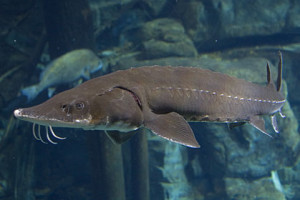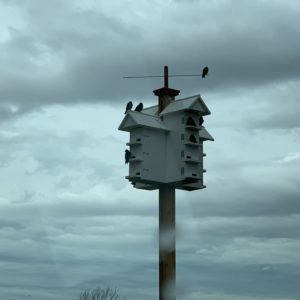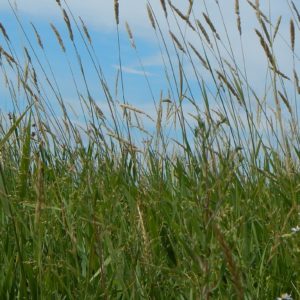Species Spotlight: Lake Sturgeon
Get to know some of the species at risk in the Lac Deschênes IBA with the Species Spotlight, aka “Sp-Spot”. Today meet the: Lake Sturgeon

Lake Sturgeon
Scientific Name: Acipanser fulvescens
SARA status: Not listed, Ontario: Threatened, Quebec: Likely to be designated
Taxonomic group: Fishes
Size: Up to 180 kilograms, and over 2 meters long
The largest freshwater fish in Canada, the Lake Sturgeon, can be easily recognized by its external bony scutes which are noticeable ridges along the fish’s body which are more noticeable in larvae and juveniles. They also have a pointed snout and 4 dangling whisker-like organs, called barbells, located around the mouth. The Lake Sturgeon has shark-like features such as a cartilaginous skeleton and an extra fin at the back to help it maneuver known as a caudal fin.
Lake Sturgeons can be found at depths of at least 5 meters but no greater than 20 meters. They move to shallower water, at depths of 0.6 and 5 meters to spawn in both rivers and lakes in areas with high currents, as well as in open shoals. The water Lake Sturgeon use to spawn is fast flowing, usually under waterfalls, rapids or dams. The substrates of these areas generally include hard-pan clay, sand, gravel and boulders. Lake Sturgeon will travel up to 400 km to their spawning areas, returning every year to the same location they were born in. If the Lake Sturgeon is unable to spawn in their usual areas they will spawn in deeper water where a similar habitat is available.
Males will take up to 18-20 years to reach sexual maturity, while females take a longer 20-24 years. However females live to approximately 150 years while males only live an average of 55 years. The number of eggs produced during spawning can range between 50,000 to over 1,000,000 depending on the size of the fish. The eggs incubate for between 7-10 days, and in water with temperatures of 13-15 ̊C.
Lake Sturgeon is a threatened species because it was overfished starting in late 1800’s early 1900’s. At first these fish were caught because of the damage they did to fishing gear, but soon there became a market for the fish and their eggs and they became a commercial product.
Where else can you see this species?
Lake Sturgeon can be found in Canada from Alberta to the St. Lawrence drainage in Quebec, and from the southern Hudson Bay region to lower Mississippi and Alabama. Lake Sturgeon are largely found in the Great Lakes-upper St. Lawrence river, northwestern Ontario, and southern Hudson Bay- James Bay.
Did you know?
• Lake Sturgeon are considered living fossils due to the lack of changes they have undergone from the Devonian period to today.
• The largest Sturgeon ever recorded was found in Roseau River, Manitoba weighing 185kg and measuring 4.6 meters long.
• The Lake Sturgeon is the only strictly freshwater species of Sturgeon found in Canadian waters.
• The oldest recorded Lake Sturgeon recorded was 155 years old; and was found in Lake Huron.
• Lake Sturgeon are omnivores, meaning that they eat both plants and animals.
Check back every week to read about a different species at risk that can be found in Lac Deschênes.
You can report sightings of this and other rare species to the Canadian Wildlife Service at (819) 997-2800 or on the MNR Natural Heritage Information Centre website. A photo and a location are very helpful!
We would like to thank our guest blogger Rebecca Perrin for this post. Rebecca is a Co-op student with Nature Canada who loves to spend time enjoying the beauty of nature.




